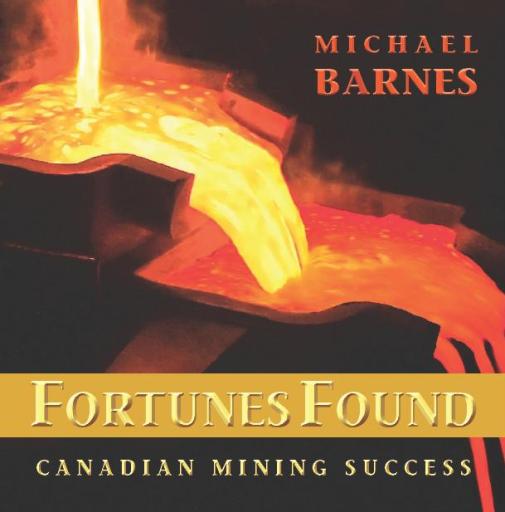 Michael Barnes is the author of more than fifty books about characters, communities, mining, and police work. He is a Member of the Order of Canada and makes his home in Haliburton, Ontario, Canada. While living in Northern Ontario most of his life, he has come to know and admire those who make their living in the mining industry.
Michael Barnes is the author of more than fifty books about characters, communities, mining, and police work. He is a Member of the Order of Canada and makes his home in Haliburton, Ontario, Canada. While living in Northern Ontario most of his life, he has come to know and admire those who make their living in the mining industry.
To order a copy of “Fortunes Found – Canadian Mining Success” go to: General Store Publishing House
For an extensive list of articles on this mineral discovery, please go to: Ontario’s Ring of Fire Mineral Discovery
Ontario’s Ring of Fire Discovery
The hour-long flight offers an overview of small trees, narrow, winding rivers, and small lakes. The aircraft skims along at 283 knots and bumps down on schedule on the dirt runway at Fort Hope, whose traditional name is “Eabmetoong.” This settlement is on a fairly large lake, and the name means “the reversing of the water place.” The pilots stow baggage that accompanies the newcomers. One young mother has her baby in a soft, moosehide-covered tikanagan, the cradle of the Cree. The flight to Landsdowne House or Neskantaga is only about ten minutes. The population is similar to that of Fort Hope, less than 300 persons for this settlement on Attawapiskat Lake. The plane takes off and has another short hop of fifteen minutes before arriving at Webequie, the third dirt runway of the trip.
Although the resident population is only 253 persons, Webequie is an important community, as it is a jumping-off point for northern exploration camps. The band council has taken a 20 percent share in a drilling company, and local entrepreneurs have formed a logistics company to provide services to camp operators. This village is 540 kilometres by air from Thunder Bay. The location is on a peninsula of Eastwood Island on Winisk Lake. The author hitches a ride to the lakeside base of West Caribou Air, a small float plane service. But on arrival, he is in luck, as the Wiskair helicopter based at his destination, the Noront Resources camp of Coper – Esker Lake, is ready to leave, having made a pick-up of a driller and some machine parts.
Pilot Jamie Gould, a flight instructor back home in British Columbia, gives a fast briefing. One must approach the passenger compartment from the front, head down. This avoids contact with the low-slung tail rotor. The machine takes off with that side-upward curving motion favoured by pilots, and the twenty minute trip is made at 160 mph at only 400 feet, due to the low-lying cloud. The interior is whisper quiet, and this five-passenger Bell 407 is known in some circles as the racing car of helicopters for its speed and manoeuvrability. The pilot remarks that at a price tag of $2 million, one must expect superior performance.
In the great arc that makes up what has become known as The Ring of Fire, McFauld’s Lake, where
Freewest has found massive sulphide deposits, is practically at the centre of the arc of claims. Our destination is Coper Lake, some thirteen kilometres southwest of this point. The Coper Lake camp — there is no physical indication of an esker — is about five kilometres inland from the lake and is roughly 288 kilometres west of Fort Albany and 324 kilometres north of Geraldton.
There are six camps within the “ring” area, but due to confidentiality and policy concerns of the assorted companies, there is little if any interaction between these remote exploration camps. Meanwhile, the helicopter homes in on the camp. Fortunately, the pilot knows the way, since the only reference for direction is the cockpit compass.
Bruce MacLachlan is the camp manager — logistics manager in company parlance — for Noront. He is a veteran of such camps across Canada but was originally a prospector and vows he will go back to that trade one day. His pal Amber, a golden retriever, is the unofficial greeter, and everyone passing by gives her a pat. Bruce explains that while there are presently forty-six persons in the camp, it could swell to sixty, and of that number, only five work directly for the company, the others providing services under contract. There are two resident geologists and a dispatcher, Alex Robinson, a helicopter pilot and aerial firefighter back home in British Columbia.
His job is to keep track of the fixed-wing aircraft and helicopters and see they are best used, and to schedule flights in and out of the camp. Since most other persons are on fixed work periods, this can be a busy job in addition to his other duties. Take the drillers: They usually work twenty-eight days straight and then go “out” for fourteen. Bruce remarks that Marten Falls First Nation is building an airstrip not far from the camp, and this should make transport much easier.
Part 4 of 6 – To be continued























